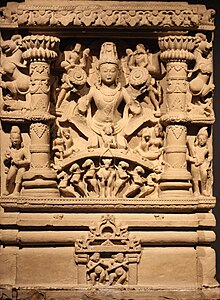Surya
Surya ( Sanskrit सूर्य sūrya "sun") is in the oldest scriptures of Hinduism , the Vedas , the personification of the sun, warmth and light or the sun god , whom many believers still worship in various forms today. Occasionally Surya appears in the Vedas in feminine form as the daughter of the sun. Surya embodies the midday and evening sun. Often times Savitri is viewed as the god of the early morning sun, a Vedic god who later merged with Surya.
mythology
The Rig Veda describes Surya as the "Eye of Heaven" and "Eye of Mitra , Varuna and Agni ". A parallel in the Egyptian religion is the eye of Re , which is also considered a sun symbol; a parallel in Zoroastrianism is the description of the sun as "the eye of Ahura Mazda ". According to the Purusha sukta , the sun emerged from the eye of the cosmic giant Purusha . Surya is also considered to be one of the manifestations of Agni, the fire form of the divine. If Agni is fire itself on earth, it is Surya, the sun, in heaven. Surya is also one of the Adityas , a group of twelve Vedic deities who are all different aspects of the sun. Surya's symbol is the swastika , which is a symbol of the sun wheel in the ancient world. Surya wears golden armor and has golden hair and golden arms. Sometimes he is also shown with a dark red body color. In his hands he carries the lotus, club, shell and wheel. The god is particularly closely associated with health, long life expectancy, success, destruction of opponents and inner enlightenment.
Surya is the brother of Indra and Agni. Ushas is sometimes seen as his sister, but sometimes also as his companion and lover. He himself is either the son of Dyaus (heaven) and Prithivi (earth) or the goddess Aditi . According to some tradition, his children include his sons Yama and Manu and his daughter Yamuna . His mother Aditi once pushed him away as the only son because she couldn't stand the scorching heat. It is the same with his wife Saranyu , who runs away from him, hides from him and turns into a mare. She asks her maid to take her place at Surya's side. But Surya finds her in a forest, turns into a stallion and with her begets the warrior Revanta , the planet god Sani and the two Ashvins , golden twins and harbingers of the dawn. Saranyu's father later planes off part of Surya so that Saranyu can safely stay with him. The falling parts of Surya fall to the earth and become the weapons of the gods.
In later Hinduism, Surya merges with various older deities, such as Mitra , Pushan , Savitri or Vivasvat , who are then considered aspects of the sun god.
presentation
Similar to Helios in Greek mythology, Surya steers a heavenly chariot ( pushpaka vimana ; see also ratha ) made by the divine Vishvakarman from the rays of the sun , which is pulled by seven horses that stand for the seven days of the week. On top of it sits the goddess Chhaya , (shadow), Surya's wife. The Vedas describe it as a "jewel in the sky". It gives light and warmth and is the cause of day and night. Surya's divine charioteer is his friend Aruna , the god of dawn. Most of the time, however, Surya is shown standing as a single figure; in his arms he often carries two lotus flowers, which unfold to blossom next to his head.
Adoration
When Hindus worship Surya, they do not mean the 'object of the sun', but the 'principle of the sun', the light that recurs daily and is also supposed to drive away spiritual darkness. Some pray the Gayatri mantra , especially at sunrise , which expresses the desire for spiritual light and enlightenment . This is addressed to Savitri ("the driver"), the aspect of the sun before it rises. Other believers have the custom of bowing to the sun with folded hands in the morning. A physical form of sun worship is the so-called 'greeting to the sun', the Surya Namaskar exercise from the Hatha Yoga system.
Among the most important Surya temples in India include the 13th-century complex in Konark ( Odisha ), of the UNESCO - World Heritage heard and Martand Sun Temple ( Jammu and Kashmir ) from the 8th and Modhera ( Gujarat ) from the 11th century.
literature
- Shanti Lal Nagar: Sūrya and Sun Cult: In Indian Art, Culture, Literature and Thought. Aryan Books International, New Delhi 1995
- VC Srivastava: Sun-Worship in Ancient India. Indological Publications, Allahabad 1972
Web links
Single receipts
- ↑ a b Swami Harshananda: Hindu Gods and Goddeses , Sri Ramakrishna Math, Madras, ISBN 81-7120-110-5
- ↑ Rigveda 1,115 de sa ; 7,61,1 de sa ; 10,37,1 de sa ; Sources according to Mircea Eliade : The Religions and the Holy , Salzburg 1954, p. 171
- ↑ RV 1,115.1 de sa ; 6.51.1 de sa ; 7.63.1 de sa ; WYV 4.35; WYV 7.42; WYV 13.46; AV 13.2.35
- ↑ Rigveda 10.90 de sa ; Source according to Mircea Eliade : Die Religionen und das Heilige , Salzburg 1954, p. 171
- ↑ Anneliese and Peter Keilhauer: The visual language of Hinduism. The Indian gods and their symbolism. DuMont, Cologne 1983, p. 228ff, ISBN 3-7701-1347-0
- ↑ Rachel Storm, Encyclopedia of Eastern Mythology , Reichelsheim 2000, ISBN 3-89736-305-4 , page 161
- ^ Gerhard J. Bellinger : Knaurs Lexikon der Mythologie, Munich 1999, ISBN 3-8289-4154-0 , page 469/470: Surya
- ^ Gerhard J. Bellinger : Knaurs Lexikon der Mythologie, Munich 1999, ISBN 3-8289-4154-0 , page 438

